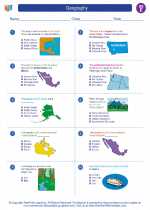Biodiversity
Biodiversity, short for biological diversity, refers to the variety of life on Earth at all levels, from genes to ecosystems. It encompasses the different species of plants, animals, fungi, and microorganisms, the genetic differences within and between these species, and the ecosystems they form. Biodiversity is crucial for the health and stability of ecosystems, as well as for the well-being of human societies. It provides us with essential ecosystem services such as clean air and water, soil fertility, pollination, and climate regulation.
Levels of Biodiversity
Biodiversity can be categorized into three levels:
- Genetic diversity: This level refers to the variation within species. It includes the differences in genes, such as variations in traits, characteristics, and adaptations.
- Species diversity: Species diversity refers to the variety of species within a given ecosystem. It encompasses the different species of plants, animals, fungi, and microorganisms.
- Ecosystem diversity: Ecosystem diversity relates to the variety of ecosystems present in a particular region. It includes different habitats, communities, and ecological processes that occur within these ecosystems.
Importance of Biodiversity
Biodiversity is essential for the following reasons:
- Ecosystem stability: Biodiverse ecosystems are more resilient and better able to withstand environmental changes or disturbances.
- Human well-being: Biodiversity provides us with food, medicine, clean water, and other resources essential for human survival and development.
- Economic value: Biodiversity supports industries such as agriculture, forestry, and tourism, contributing to the global economy.
- Cultural significance: Many cultures and indigenous communities rely on biodiversity for their traditional knowledge, spirituality, and cultural practices.
Threats to Biodiversity
Biodiversity faces numerous threats, including habitat destruction, climate change, pollution, overexploitation of natural resources, and invasive species. These threats can lead to the loss of species, disruption of ecosystems, and negative impacts on human well-being.
Conservation of Biodiversity
Efforts to conserve biodiversity include the establishment of protected areas, sustainable land and resource management practices, restoration of degraded ecosystems, and international agreements and conventions aimed at biodiversity conservation.
Study Guide
Here are some key points to include in your study of biodiversity:
- Define biodiversity and its three levels: genetic diversity, species diversity, and ecosystem diversity.
- Explain the importance of biodiversity for ecosystem stability, human well-being, economic value, and cultural significance.
- Identify and describe the major threats to biodiversity, such as habitat destruction, climate change, and overexploitation of natural resources.
- Discuss the various conservation efforts and strategies aimed at protecting and preserving biodiversity.
- Research and present a case study of a specific ecosystem or species facing threats to its biodiversity, and propose potential solutions for its conservation.
Understanding biodiversity is crucial for recognizing the value of nature and the importance of preserving and protecting the variety of life on Earth.
[Biodiversity] Related Worksheets and Study Guides:
.◂Social Studies Worksheets and Study Guides Fifth Grade. Geography

 Worksheet/Answer key
Worksheet/Answer key
 Worksheet/Answer key
Worksheet/Answer key
 Worksheet/Answer key
Worksheet/Answer key
 Worksheet/Answer key
Worksheet/Answer key
 Worksheet/Answer key
Worksheet/Answer key
 Worksheet/Answer key
Worksheet/Answer key
 Worksheet/Answer key
Worksheet/Answer key
